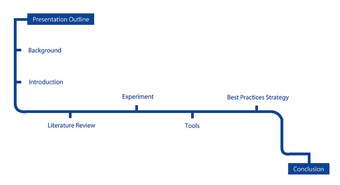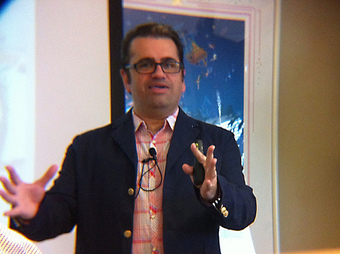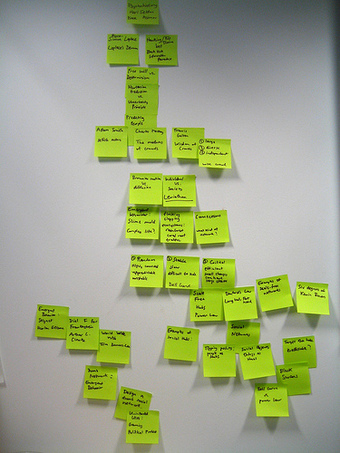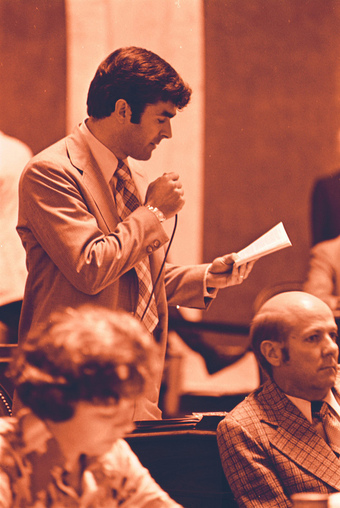10.1: Principles of Organization
10.1.1: The Importance of Organization
Good organization is the key to effective communication because it helps make your ideas accessible to your audience.
Learning Objective
Explain how information, knowledge, and wisdom work together in a speech
Key Points
- Public speakers can structure the audience’s experience through skillful organization. As you write your speech, decide what you want your audience to feel in the beginning, middle, and end of your speech.
- An effective speech should balance information, knowledge, and wisdom.
- Information is the foundation of knowledge; knowledge is the basis of wisdom.
Key Terms
- wisdom
-
Wisdom refers to insight that is gained from knowledge. This category includes truth, opinion, and perception.
- knowledge
-
Familiarity or understanding of a particular skill, branch of learning, etc.
- information
-
The category of information includes facts, figures, and concepts taken from primary and secondary texts.
Why Does Organization Matter?
William Carlos Williams once said that a poem is a “machine made of words. ” A sad poem is a machine that manufactures melancholy; a funny poem is a machine that produces laughs. Poetry doesn’t have a monopoly on this quality–a well-crafted speech can also be a machine made of words. Skillfully constructed language has a powerful effect on its audience, and speechwriters should strive to harness that power. How should a public speaker go about building a “machine made of words”? It’s all in the organization. Machines only work when their component parts are assembled properly.

Organizing a Speech
A well-organized speech is like a well-oiled machine.
When you are organizing your main points, ask yourself a few questions. What is your ultimate goal? Are you trying to inform the audience, persuade the audience, amuse the audience, or enrage the audience? Think about the experience you want to create for your listeners–how you want them to feel when you begin speaking, and how you want them to feel when you make your final statement. When you have a clear vision in mind, return to the “Ordering Main Points” segment and choose a model that fits your purpose.
For example, let’s say you are preparing a speech to solicit money for political dissidents in Chechnya, and you want to motivate your listeners by shocking them. If shock is the desired effect, it would be ineffective to spend ten minutes pontificating generally about the virtues of free speech without mentioning the specific abuse that the fundraiser addresses. It would be more effective to open with the story of an abused dissident who could benefit from the fundraiser’s efforts–a story that would show the audience how high the stakes are, and how donations could help.
Information, Knowledge, and Wisdom
Where is the Life we have lost in living?
Where is the wisdom we have lost in knowledge?
Where is the knowledge we have lost in information?
-T.S. Eliot
T.S. Eliot makes a good point: it is difficult to maintain a healthy balance of information, knowledge, and wisdom. When we write speeches, we mix material from the three main registers of meaning: information, knowledge, and wisdom. For our purposes, let’s define information as facts, figures, and concepts taken from primary and secondary texts. Knowledge is more general than information: it refers to the ideas that come from processing information, rather than the information itself. Knowledge is the synthesis of many facts. This category includes stories, principles, and contexts. Wisdom, the most general category of all, refers to insight that is gained from knowledge. Wisdom includes truth, opinion, and perception.
To put it in concrete terms, let’s look at the information/knowledge/wisdom breakdown in a speech about performance-enhancing drugs in sports:
Information: statistics about athletes’ steroid use
Knowledge: stories about athletes who take steroids
Wisdom: suggestions about ethics in sports
All three of these elements should work together. If your speech is too heavy on information and light on knowledge and wisdom, your message may get lost in the details. A speech that presents knowledge without information to support it or wisdom to justify it may seem pointless. “Wisdom” offered without information and knowledge to ground it in reality may come across as a vapid collection of clichés.
Good organization can prevent these problems. Balance information, knowledge, and wisdom as though you are building a house: lay a strong foundation of information, build knowledge on top of it, and finish the house with a roof of wisdom.
10.1.2: Critical Thinking
Learning how to think critically is a vital part of the organizational process of crafting an effective speech.
Learning Objective
Use critical thinking to craft an effective speech
Key Points
- Critical thinking consists of intentional, reflective thinking about a given set of information and determining not only what to believe about that information but also how to act on it.
- Critical thinking consists of the following six key processes and actions: clarifying goals, examining assumptions, discerning hidden values, evaluating evidence, accomplishing actions, and assessing conclusions.
- You must utilize the many elements of critical thinking to pinpoint your goals and articulate compelling, relevant, accurate evidence in your speech. Additionally, critical thinking allows you to examine your thesis from opposing viewpoints, giving you further strategies to bolster your argument.
Key Term
- critical thinking
-
he application of logical principles, rigorous standards of evidence, and careful reasoning to the analysis and discussion of claims, beliefs, and issues
Critical thinking consists of intentional, reflective thinking about a given set of information and determining not only what to believe about that information but also how to act on it. When you think of delivering a speech or a public address, you might not think that critical thinking plays a key role in the delivery of that speech. The key to a successful delivery lies in the speech’s logical structure and organization of thought. Critical thinking is an important part of that organizational process.
Speeches typically serve one of four basic purposes: to inform, to persuade, to demonstrate, or to entertain. Constructing your speech with an effective thesis or main point and evidence to support that thesis requires you as the speechwriter to use critical thinking to determine how you’ll make those points. Fully understanding the context of your speech is one of the most important elements of critical thinking in your speechwriting process.
Critical thinking consists of the following six key processes and actions:
- Clarify goals
- Examine assumptions
- Discern hidden values
- Evaluate evidence
- Accomplish actions
- Assess conclusions
In regards to public speaking, each of these is a process to undertake as you craft your speech.

Critical Thinking
Critical thinking is an important step in the process of writing an effective speech.
Clarifying Goals
Before you begin outlining your speech, consider exactly what you’re trying to accomplish. Are you trying to inform or instruct your audience on a particular subject? Do you seek to persuade them to feel a certain way about your topic? By considering your purpose for speaking, you can more clearly articulate your goals for the speech.
Examining Assumptions
As you pinpoint your thesis and main points, you’ll begin to outline exactly how you plan to support your argument. In order to present a clear and well-reasoned argument, you’ll need to make sure you have accurate and specific evidence to support your claims. By examining assumptions that may be made about your particular thesis, you can more clearly hone and refine the evidence you choose to present to bolster your case.
Discerning Hidden Values
Have you considered all the possible ways to present your main thesis and all the possible evidence you could include? Consider your thesis from opposing points of view. Using this critical thinking skill of discerning hidden values gives you a comprehensive way to approach your speech from all possible points of view.
Evaluating Evidence
Now that you know all the possible angles from which others can approach your line of reasoning, now it’s time to select the best evidence to support your thesis. By evaluating evidence with a critical eye, you’ll strengthen your argument by selecting the most compelling evidence to make your point.
Accomplishing Actions
Now that you’ve outlined your purpose, goals, and evidence, how exactly will you set out to accomplish those goals? Considering what actions you hope your speech will provoke will further guide you in the process of carefully selecting every word and sentence that brings you closer to realizing those goals.
Assessing Conclusions
Once you’ve written your speech, will your audience come to the same logical conclusion as you? Assessing the ways in which your audience will come to their own conclusions about your material will influence all the other pathways of critical thinking about your speech. You can then go back and tailor your evidence and content more appropriately so that your audience reaches the same conclusions you set out to present.
In sum, critical thinking is a vital part of the speechwriting and public-speaking process, a skill that you should work to develop in order to craft effective speeches.
10.1.3: Components of a Speech: Main Points, Introduction, Conclusion, and Transitions
A speech should have four components: the main points, introduction, conclusion, and transitions.
Learning Objective
Name the different components of a speech
Key Points
- Composing a speech is different from writing an essay. Write with listeners in mind, not readers.
- The bulk of a speech is different from the body of an essay. An essay is a careful, detailed scaffold that builds points over multiple pages, whereas a speech should stick to a few overarching points or themes.
- Public speakers can emphasize transition points with visual aids, body language, vocal delivery, and transitional words and phrases.
Key Term
- transition
-
The process of change from one form, state, style, or place to another.
Components of a Speech: Main Points, Introduction, Conclusion, and Transitions
A speech is more than simply an essay that is read aloud. Listening to a speaker is inherently different from reading a page, and public speakers should keep that difference in mind as they prepare their work.
A traditional academic essay consists of an introduction, a body with alternating concrete details and commentary, and a conclusion. The role of the introduction and conclusion are similar in speeches and essays, but the “body” is a different matter. Break free of the essay mindset, and try to think of a speech as the sum of four components: the main points, introduction, conclusion, and transitions. What’s the difference? Read on to see what is special about the components of a speech.
Main Points
Thinking of “main points” rather than a “body” can help speakers remember to keep it simple. A restless audience may not have patience for the predictable, orderly progression of concrete details and commentary that is typical in the body of an academic essay. Above all, communicate a few important points!
Introduction
The introduction should get the audience’s attention, describe the topic, state the thesis or purpose, and give an overview of the speech and its main points. Open with a detailed map of your speech–giving good directions in the beginning will save your audience from getting lost along the way.
Conclusion
The conclusion should summarize main points and state a strong thesis. Remember that many people struggle with auditory learning, and consequently have trouble focusing on spoken words. Your listeners may not put everything together on their own, so you should make it easier for them by summarizing your argument and reviewing central ideas in the conclusion.
Transitions
A transition is a change or shift from one topic to another. It may be surprising to see that transitions are one of the four key components of a speech. Academic writers tend to think of transitions as important stylistic elements rather than essential building blocks. However, transitions are crucial for public speakers, since speakers need to compensate for the loss of visual formatting. On a written page, formatting provides a helpful road map: the reader sees topic headings, paragraph breaks, and other visual cues that signal transitions naturally. Speakers can replicate these cues and signal transitions using visual aids and body language, but it will take more conscious effort than simply hitting “enter” to create a paragraph break. Speakers can emphasize transition points with visual aids, body language, vocal delivery, and transitional words and phrases.
Visual Aids for Transitions
Visual aids such as slides and handouts are a great way to guide the audience through your transitions. A slide or handout with topic headings printed on it is a good road map for a speech, preparing the audience for any twists and turns that may come up.

Transitioning Together
Effective transitions will help the audience follow your speech as it moves from topic to topic.
Transition Words and Phrases
These words and phrases signal a change, giving the audience a “heads up” about an upcoming transition:
Connecting:
- additionally
- also
- again
- moreover
- furthermore
- coupled with
- for example
- for instance
- likewise
- similarly
- specifically
- indeed
- in fact
Contrasting:
- however
- although
- but
- nevertheless
- on one hand
- on the other hand
- besides
- yet
- on the contrary
- conversely
- comparatively
Concluding:
- overall
- above all
- therefore
- thus
- accordingly
- consequently
- in conclusion
- finally
- in essence
- in other words
- in short
10.1.4: Patterns of Organization: Informative, Persuasive, and Commemorative
The three main categories of speech are: informative, persuasive, and commemorative.
Learning Objective
Discuss the goals of informative, persuasive, and commemorative speeches
Key Points
- When you begin organizing your speech, determine what your broader purpose is–to inform, persuade, or commemorate.
- Keep the purpose of your speech in mind as you try different structural models.
- Different structures are suited to different purposes, and you may have to experiment with a few models before you find the right one for your speech.
Key Terms
- persuasive speech
-
A persuasive speech makes a convincing case for its position or viewpoint.
- commemorative speech
-
A commemorative speech honors, celebrates, or remembers its subject.
- informative speech
-
An informative speech educates the audience about its topic.
Patterns of Organization:
As you organize your main points, keep your “big picture” goal in mind. Are you trying to inform your listeners about an issue? Or trying to persuade them to share your opinion? Perhaps you are commemorating an event?
Different goals call for different narrative structures and you may need to try a few models before you find one that suits. To aid your trial-and-error process, refer to the list of structural models in the previous chapter for ideas. If you haven’t looked at these recently, it may be helpful to review “Ordering Main Points” before reading on. The following provides examples of some of these in action.
Informative
An informative speech should educate the audience about its topic. These speeches are not argumentative—they describe, announce, or explain their subject without making a case or taking sides.
Catering to the audience’s needs is important in any speech, but it is crucial in an informative speech. This type of speech relies on the value of the information itself, without the added appeal of a conversion experience or an emotional catharsis. Make sure your information will be useful and interesting to your audience!
Here are some sample topic statements that illustrate different approaches to framing an informative speech:
Cause and Effect
- Consumers listed rising gas prices and falling prices for electric vehicles as the main reasons behind their new interest in electric cars.
Compare and Contrast
- Studies have found major demographic differences between consumers who would consider buying electric cars and those who would not, but both groups still share the same concerns.
Categorical
- Market research shows that consumers weigh three main issues when they consider buying an electric car: purchase price, convenience, and long-term cost savings.
Chronological
- The market for electric cars has evolved significantly in the years between its invention in the late nineteenth century and the mass-production of electric cars today.
Biographical
- Belgian inventor, Camille Jenatzy, combined solid engineering skills with a flair for publicity stunts to build a successful electric vehicle company in the 1890s.
Persuasive
A persuasive speech should make a convincing case for its position. While some are intended to win passive agreement from the audience, others encourage immediate action. For example, a speech arguing that drug-resistant bacteria strains are a serious problem seeks only passive agreement. However, if the speech went one step further and urged listeners to reduce their own consumption of antibiotics, it would belong to the second category.
If you want your audience to do something, end your speech with a call to action and explain how your listeners could help the cause.
These thesis statements about antibiotic-resistant bacteria illustrate different structural models for persuasive speaking:
Cause and Effect
- The U.S. industry standard of giving daily antibiotics to healthy livestock promotes the creation of antibiotic-resistant bacteria.
Problem-Cause-Solution
- Dangerous bacteria are adapting to resist antibiotics on under-regulated U.S. farms. The FDA should scrap its useless “voluntary guidelines” for agribusiness and impose legally-binding restrictions on the practice of feeding antibiotics to healthy animals.
Compare and Contrast
- The European Union banned the routine feeding of antibiotics to livestock as part of its quest to fight antibiotic-resistant bacteria. Compared to the strict regulations in other industrialized nations, the U.S. policy of trusting agri-businesses to regulate themselves seems outdated and irresponsible.
Categorical
- The case for legally-binding restrictions on agricultural consumption of antibiotics should be evaluated in terms of its costs, benefits, and practical feasibility.
Chronological
- The European Union banned the practice of routinely feeding antibiotics to healthy livestock in 2004. Since then, calls for similar legislation in the U.S. have become increasingly urgent as new studies warn of public health risks from antibiotic-resistant bacteria.
Biographical
- Dr. Marc Sprenger of the European Centre for Disease Control and Prevention draws on his experience as a doctor and epidemiologist to combat antibiotic-resistant bacteria.
Commemorative
A commemorative speech should honor, celebrate, or remember its subject. These sample statements of purpose memorialize different aspects of the Titanic:

Autographed Postcard
Three survivors of the Titanic, including Eva Hart, signed a postcard commemorating the tragedy.
Cause and Effect
- The sinking of the Titanic inspired a new wave of maritime safety laws. My panel will discuss the life-saving provisions we owe to that tragedy.
Compare and Contrast
- The passenger carrier Lusitania sank only three years after the Titanic and claimed nearly as many lives. However, the legend of the Titanic overshadows the Lusitania’s story. When I compare these two tragedies, I find myself asking—how different are they, really?
Categorical
- Are we justified in our nostalgia for a bygone era of chivalry? Behavioral economists have taken one step toward answering this question, using data from the Titanic and the Lusitania to study social norms in disaster responses. How many men actually gave up lifeboat seats to women and children? I will address these questions by analyzing the effects of age, gender, ticket class, and family structure on an individual’s chance of surviving one of these disasters.
Chronological
- After the Titanic sank in 1912, the White Star Line spent four years in arbitration before reaching a deal to cover 16 million in legal claims with a settlement of 664,000. Let’s give that controversial legal battle a retrial from beginning to end to see if the settlement is actually a fair outcome.
Biographical
- Tonight, we are gathered to celebrate Eva Hart, who was only seven years old when she sat on a lifeboat watching the Titanic sink into the sea with her father on board. The experience left her with terrible nightmares, but she overcame her fears and lived a full life as a singer, politician, and magistrate.
While informative speeches explain, educate and describe; persuasive speeches raise the stakes by using information to influence the audience; commemorative speeches assume a shared emotional connection to the subject.
10.1.5: Building a Speech: Starting with an Outline
The process of creating an outline can help speechwriters organize their main points and evidence.
Learning Objective
Describe the process and methods for creating a speech outline
Key Points
- If you are having trouble writing your outline, try brainstorming first.
- A topic outline, or a general list of topics, evidence, quotes, and other details, is a good way to organize your main points and create a general overview of the speech.
- If you want to make an outline that includes text from the actual speech, write a sentence outline.
Key Terms
- sentence outline
-
A sentence outline expresses the central ideas of a speech in complete sentences.
- topic outline
-
A topic outline is a hierarchical list of a speech’s main points. Topic outlines use keywords and short phrases rather than complete sentences.
- outline
-
A list used to present the main points or topics of a given subject, often used as a rough draft or summary of the content of a document.
Building a Speech: Starting with an Outline
It is always a good idea to make an outline before you begin writing a speech. An outline is a structural plan that lists main points, summarizes claims, and serves as a guide for the writing process. Working from an outline can help you organize your speech and put supporting elements, such as definitions and supporting evidence, in order. Some outlines are minimal, providing a quick sketch of a speech’s main points. Other outlines are very detailed, filling in a skeleton of topic headings with topic sentences, pieces of evidence, and transitions.
Many students are familiar with outlining techniques from academic writing classes. Outlining a speech is similar, but there is one key difference: speechwriters can use the outlining process to create prompts to aid with delivering the speech. Some speakers like to use handwritten notes, others use cue-cards, still others read from a printed script, and some experienced speakers don’t use any prompts at all. Ideally, with practice, you will avoid reading a script word-for-word—burying your face in papers for the entirety of the speech will limit your ability to engage the audience. However, minimal prompts such as cue cards and outline-style notes may help you stay on topic and remember main points. Whether or not you plan to use prompts, creating an outline is a great way to refine your argument—and you can always ignore it once you begin writing.
Brainstorming
Many speakers like to brainstorm before making an outline. Brainstorming, which involves techniques such as creating “idea maps” or flowcharts that connect ideas and evidence, is less formal and structured than outlining. It is a great place to begin if you’re having a hard time settling on a definite plan for your speech.
Topic Outline
A topic outline is a hierarchical list of a speech’s main points. Topic outlines tend to use keywords and short phrases rather than complete sentences. A topic outline is fragmentary—it serves as a prompt, rather than a draft of material to use in the actual speech.

Creating an Outline
This outline provides a general overview of the structure of a science presentation.
Sentence Outline
A sentence outline expresses the central ideas of a speech in complete sentences. Sentence outlines are more detailed than topic outlines, but less detailed than first drafts.
10.2: Main Points
10.2.1: Choosing the Main Points
The needs, interests, and expertise of the audience should be the central consideration in choosing main points.
Learning Objective
Demonstrate a variety of methods to help you choose your main points based on your audience and the purpose of your speech
Key Points
- If you are speaking to a homogeneous audience, research the particular interests of that group and tailor your speech to meet their needs.
- If you are speaking to a heterogeneous audience, try to find points that will interest each segment of your audience, and also a common purpose to unify diverse elements.
- As you choose your main points, ask yourself what is at stake for the audience. Why should that particular group of people care about your topic? How will it affect them?
Key Terms
- Homogeneous
-
Having the same composition throughout; of uniform make-up.
- heterogeneous
-
Diverse in kind or nature; composed of diverse parts.
Choosing Main Points
When you are preparing a speech, it is important to establish a clear focus from the beginning. How should you narrow your focus and choose your main points? Follow the first commandment of public speaking: Know Thy Audience.
Focus on the Audience
According to a Greek philosopher named Epictetus, “We have two ears and one mouth so that we can listen twice as much as we speak. ” Epictetus’s wisdom applies to public speaking: listening to the audience is twice as important as speaking to the audience. Find out what your audience members already know about your topic, what they want to learn, and why it is important to them. If you focus on information that is obvious, irrelevant, or incomprehensible to them, you may find yourself speaking to a room full of yawns, cell phones, and backs walking out of your talk. However, if you research the demographics of your audience, you may avoid some common last-minute dilemmas: “Do I need to define this term? ” “Will this anecdote offend anyone? ” “Will anyone care about what I’m saying? “

Consider the Audience
In order to create an effective speech, the speaker needs to take the specific audience into account.
Of course, some groups are easier to figure out than others. Let’s say you are speaking at a professional development conference for paralegals. In that case, the attendees share a common purpose, which makes it easier to address their specific needs. You could look at sources such as professional journals and conference bulletins from previous years to see what issues are important to ambitious paralegals. If, on the other hand, you are speaking at a high school graduation ceremony, the audience may include a wide range of people with very little in common except the ceremony itself. In that case, your main points could focus on graduation, the one thing that binds everyone together.
Before you choose your main points, answer these questions about the audience:
- What does the audience know about my topic?
- Is the audience homogenous or heterogeneous?
- How does this topic relate to the audience?
- Why is this topic important to the audience?
- What is at stake for the audience?
- What does the audience want to learn about my topic?
- How can I show the audience that my main points are relevant and useful?
Homogeneous and Heterogeneous Audiences
A homogeneous audience is a group of people who share a consistent level of interest and expertise in your topic. A heterogeneous audience includes people with different levels of expertise and interest in your topic. It is important to determine what type of audience you have, and plan your speech accordingly. If you are writing a toast for your best friend’s wedding, you already know what your listeners want: they are gathered to celebrate the happy couple, and your toast should help them do that. On the other hand, if you are presenting scientific research to a mixed audience of academics and wealthy donors, you need to navigate a varied set of interests, agendas, and levels of knowledge as you select your main points. If there are non-experts in the audience, it is important to provide background information and define key terms. For a heterogeneous audience, you should make points that appeal to different segments of the audience, but also try to identify points that will unite your listeners under a common cause.
If you are addressing a homogeneous group, don’t take their interest for granted. It’s not a free pass–a homogeneous audience is not a captive audience. For example, if you are presenting research on business ethics to a group of specialists in your field, make sure to include points that might be applicable to their research.
The Stakes
How does your topic relate to your listeners, why should they care about it, and what is at stake for them? The answers to these questions will be your best guide in choosing main points. If you want to hold your audience’s attention, your speech needs to answer these questions as early as possible.
The Innovation
What are you adding to the existing conversation about your topic? What can your speech offer that the audience won’t find elsewhere? If you want to hold your audience’s attention, make a case for the comparative advantage of your perspective.
The Purpose
Most speeches aim to do one of three things: to inform, to persuade, or to commemorate. Choose main points that will fulfill your speech’s overall purpose:
- For an informative speech, provide a foundation of relevant information and then present knowledge and wisdom that will be useful to your audience.
- A persuasive speech assumes that your audience already has preconceptions about your topic. Address these preconceptions, and then introduce points that prove the value of your position.
- A commemorative speech usually compiles stories and wisdom that will help the audience honor, remember, or celebrate something.
Remember the broad purpose of your speech–to inform, to persuade, or to commemorate–as you choose your main points.
10.2.2: Ordering the Main Points
There are 9 different ways to organize your speech and the type of speech can help you decide which one is best to use.
Learning Objective
List ways to organize the main points of your speech
Key Points
- When ordering main points, the speaker should consider the audience and find a way to make sure the points are arranged to help retention and clarity.
- Try to limit a speech to 3 or 4 main points with supporting sub-points to make sure the audience is not overwhelmed with too much information.
- Each of the main points would require additional support and evidence in a speech and are identified only to aid the conceptualization of the organizational forms.
- Asking someone to listen to the speech can help make sure that the main points flow well and are in a order that will help maximize understanding for the audience.
Key Terms
- sub points
-
A sub point has a direct, specific relation to its major point that you can make clear by the organizational method you choose.
- chronological
-
In order of time from the earliest to the latest
Ordering Main Points
It is important to make sure that a speech flows properly to enhance understanding. When ordering main points, the speaker should consider the audience and find a way to make sure that the points are arranged to help retention and clarity .

Organizing the Main Points
Making sure the main points are ordered correctly helps the speech to flow better.
How Many Main Points?
Try to keep main points down to three or four with supporting sub points. An audience will only be able to grasp so much information at one time and the presenter does not want to bombard the audience with too much information at once. Additionally, make sure that each of your main points are supported by the same number of subpoints or evidence. This adds balance and proportion to your speech.
Ways to Organize the Main Points of Body
The following are the 9 different ways to organize your speech, including examples to help you understand better. Each of the main points, of course, would require additional support and evidence in a speech and are identified only to aid the conceptualization of the organizational forms.
Temporal Organization
This is the chronological approach; it is good choice for when you are telling a story, explaining research, or outlining a future plan.
Cause-effect
Telling why something happened; cause-effect may be used for past, present, or future events and processes. Cause-effect can also be reversed, from effect back to cause.
Example: What causes something to happen, and the result (effect) of the occurrence.
Spatial Patterns
When using spatial patterns, be sure to proceed systematically from one place to the next, following a clear order. A size sequence is a variation on spatial organization, describing different artifacts from smallest to largest (or from largest to smallest). This is useful when describing something, especially a progression through a place/time or a physical object.
Example: First you enter here, then you go through there, and you end up…
Topical
Topical is an appropriate approach when the subject matter has clear categories of division.
Example: My Family: my dad, my mom, my brothers.
Importance Patterns
This can be used to discuss the different reasons for something and then designating their importance.
Example: If you were the President’s advisor, you may come to him/her with 3 problems, organizing each in the order of importance to the country.
Compare/Contrast
The compare/contrast takes two or more entities and draws attention to their differences and/or similarities.
Example: If you were comparing apples and oranges you could use this to better clarify and prove your argument.
Problem-Solution Organization
- Problem-solution organization involves the identification of a problem followed by a possible solution.
Example: (1) Timmy does not have enough skittles (2) Ask Bobby to share.
Stock Issues
Stock issues are designed to organize presentations on issues of policy in a more complicated way than simple problem-solution. There are generally four main components to this organizational scheme:
- a description of the current system (inherency, or the inherent flaws in the current system),
- explanation of the harms that result from the current system (harms),
- a program to address those harms (a plan of action),
- reasons why the plan would be preferable to keeping the current system (solvency or why the plan would help the problem).
Monroe’s Motivated Sequence
This is good organizational tactic for persuasive speaking. It has 5 Components:
- Gain audience attention
- Show need for change
- Provide an alternative
- Benefits of the change
- A call for action
10.2.3: Highlighting the Main Points
If you want your audience to follow your main points, you should highlight them using visual and textual cues.
Learning Objective
Give examples of ways to highlight the main points in your speech
Key Points
- 65% of Americans are primarily visual learners, while 30% work best with auditory learning and 5% thrive with kinesthetic (or hands-on, touch-based) learning. This puts public speakers at a disadvantage, since only 30% of Americans learn best by listening.
- Public speakers should accept the reality of distractible audiences and take responsibility for getting the message across despite this challenge.
- Public speakers can emphasize their main points using visual and textual cues.
Key Terms
- textual cue
-
Textual cues are signals within the language of a speech: key words and phrases, examples, anecdotes, and selections of text that appear on a slide or handout.
- visual cue
-
A visual cues is a signal the audience can see. Examples of visual cues include slides, handouts, charts, and also the speaker’s body language.
Highlighting Main Points
The scenario: your teacher is droning on and on, and your mind wanders…”Mmm, food. What’s in the fridge? Should I buy groceries after class? What could I make for dinner? ” When you snap back into focus, the teacher has just finished explaining a key concept. Nothing else makes sense without that piece of the puzzle, but you can’t just turn back a page or hit rewind, so you’re out of luck! We’ve all been there, right? This is an important lesson for public speakers: no matter what you do, audience members will zone out occasionally. In an ideal world, your listeners would cherish every word that comes out of your mouth, but in the real world, that’s not going to happen. It’s practically a law of nature, so you might as well accept it and plan accordingly: highlight your main points to help your audience catch the most important ideas.
Visual and Textual Cues
Public speakers can highlight important points using visual cues and textual cues. Visual cues are cues the audience can see, including aids such as slides, handouts, and charts, and also the speaker’s body language. Textual cues relate to the content of the speech: signal words and phrases, examples, anecdotes, and selections of text that appear on a slide or handout. Take responsibility for your message and use some of these tried and tested techniques to get your message across.

Highlighting Main Points
Public speakers can use visual aids and textual cues to highlight their main points.
Highlighting with Visual and Textual Cues
Some studies estimate that 65% of Americans are primarily visual learners, while 30% work best with auditory learning and 5% thrive with kinesthetic (or hands-on, touch-based) learning. This puts public speakers at a disadvantage, since only 30% of Americans learn best by listening. Fortunately, speakers can use visual cues to make their words “stick. ” For examples of visual cues, just look at the page you are reading right now. Important points are highlighted with topic headings in large typeface, bold font, italics, bulleted lists, banks of key terms, etcetera: the visual presentation of a printed page functions as a guide for the reader. For a speech, the rules are a little bit different. To highlight key terms and new topic headings, a speaker can create slides or handouts that outline the speech’s main points. To convey the effect of italics or bold print, a speaker has to rely on tone of voice rather than visual cues. To combine visual and kinesthetic learning, speakers can poll the audience and ask them to raise their hands and look around the room to see the results. Here are several techniques for using visual aids such as slides, handouts, or posters to enhance your presentation:
Highlighting with Graphics
Graphics such as charts and pictures can make a presentation more engaging by illustrating the main points. If you support your claims with numbers, visual aids such as charts, graphs, and models would help your audience understand the figures easier and faster. If your speech describes people, places, or objects, pictures of those subjects would make your presentation more vivid and interesting.
Highlighting with Text
Visual aids such as slides, handouts, and posters are excellent ways to highlight key phrases, definitions, quotes, and lists. Spoken words can evaporate as soon as they leave your mouth, but written words stay in place–they’re not going anywhere. Try to put your most important points in concrete form. For example, a slide show that lists important definitions allows the audience to copy the definitions exactly as they appear, refer back to them, and make mental notes of the most important terms. When you make an outline of your speech, keep the question of visual aids in mind. You can save time with an outline that converts easily into visual aids: remember this when you choose subject headings, definitions, quotes, and key phrases.
Highlighting with Signal Words and Phrases
Signal words and phrases are designed to command attention. These verbal road signs have many uses, one of which is to highlight important points. Here are some examples of signal words and phrases that will alert your audience to pay attention: important, noteworthy, crucial, vital, major, principal, primary, central, valuable, defining, distinctive, relevant, above all, in the end
Highlighting with Examples
Precept is instruction written in the sand. The tide flows over it, and the record is lost. Example is graven on the rock, and the lesson is not soon lost.
-William Ellery Channing
Instructions, rules, and descriptions are all great, but if you want to make a concept stick, support it with an example. Different types of examples include facts, figures, data, illustrations, anecdotes, and quotes. As an illustration, compare the following two versions of the same point:
- Many Americans struggle with debt. For this reason, affordable health care is an important priority for our country.
- Anne Smith is one of the forty-six million Americans who live below the poverty line today. Last week, Anne arrived at the emergency room of Lutheran General Hospital unconscious and seriously injured after a drunk driver hit her and left her half dead. Anne survived, thanks to the hard-working EMTs at Lutheran General, but she woke up the next morning with $120,000 in medical bills. A health care system that cripples its patients with debt is not consistent with a healthy economy: Americans like Anne deserve better.
The second version combines facts, figures, and an anecdote to convey the human impact of the situation along with its broader significance. That is the power of example in action.
10.3: Introduction
10.3.1: The Role of the Introduction
The introduction should convince the audience that your speech will be relevant and useful by providing a general overview of what’s to come.
Learning Objective
Use the introduction of your speech to convince your audience that you have something worthwhile to say
Key Points
- The introduction is a sales pitch and a useful outline in one, so it should maintain a good balance of hype and content.
- The introduction has five important responsibilities: get the audience’s attention, introduce the topic, explain its relevance to the audience, state a thesis or purpose, and outline the main points.
- By the end of the introduction, you should provide a road map that outlines your main points.
Key Term
- introduction
-
A means of presenting one person to another.
Role of the Introduction
The introduction is the best opportunity to convince your audience that you have something worthwhile to say. An introduction can accomplish this by fulfilling five important responsibilities: get the audience’s attention, introduce the topic, explain its relevance to the audience, state a thesis or purpose, and outline the main points. By the end of the introduction, the audience should know where you’re headed and what your speech will cover. If you are giving a persuasive speech, state your thesis in the introduction. If you are giving an informative speech, explain what you will be teaching the audience.

Speech Introduction
The introduction grabs the audience’s attention and sets the tone for the entire speech.
As you write your introduction, try to answer these questions:
What is the scope of your presentation–how narrow or broad is your topic? How does it relate to the audience? What is at stake for the audience? Do you have any new insights or special perspectives to add to the existing discussion of your topic? Why should the audience listen to you instead of someone else? Will you be informing the audience, or making an argument?
The Road Map
By the end of the introduction, you should provide a brief overview of your main points. This “road map” will help the audience understand the main points in the context of your larger purpose. Without a good map to follow, the audience is liable to get lost along the way. A good introduction is the best way to make sure your message gets through.
In sum, the introduction should:
- Hook the audience.
- Describe your topic.
- Explain how your topic is relevant to the audience.
- Explain the stakes at hand.
- Establish credibility: What authority do you have to discuss this topic?
- State your innovation: What is new or special about your perspective?
- Lay out a road map of your speech.
- Outline your main points.
- State your thesis or purpose.
Writing the Introduction
If you have an anecdote, quote, question, or some other “hook” that inspires you to start writing the introduction, go for it. Don’t take inspiration for granted! In some cases, the right story will set up a natural sequence for your main points, launching the speech effortlessly. Otherwise, it may be easier to begin the introduction after you write about your main points. Working through the main points will set the destination of the speech, and it doesn’t hurt to have a clear idea of where you’re going before you set out. If you finish writing the body of your speech and come back to the introduction uninspired, refer to the chapter, “Getting Attention and Interest” for more ideas about effective openings.
10.3.2: Getting Attention and Interest
In order to win the audience’s attention and interest, write a dynamite opening and then give a quick overview of your speech.
Learning Objective
Give examples of ways to hook your audience’s attention with the first words of your speech
Key Points
- The opening of a speech is the most important time to get the audience’s attention and generate interest.
- One way to grab the audience’s attention is to begin with something surprising, shocking, or controversial.
- If a subdued approach is more appropriate, try opening with a question. In academic contexts, it may be best to start by situating your talk within the existing conversation.
Key Term
- anecdote
-
An account or story which supports an argument, but which is not supported by scientific or statistical analysis.
Getting Attention and Interest
Public speaking is essentially the art of convincing an audience to listen to you against all odds. How can you pry your listeners away from their day-to-day concerns? What would make you the most interesting person in their lives—at least until you finish your speech? You need to act fast, since first impressions tend to overshadow all other impressions. The opening of your speech will determine the audience’s willingness to listen. Learn how to deliver a dynamite opening, and you can make that fact work in your favor.

Attracting Interest
Getting the audience’s attention is like showing someone a wrapped present. It should peak their interest.
Strategies for the Opening
Here are eight ways to open a speech with panache:
1. Make a provocative or controversial statement. You can back down from an extreme position later, but controversy is an effective way to capture the audience’s attention.
Example: The United States should control its population growth by imposing fines on parents who have more than one child.
2. State a surprising or little-known fact.
Example: Did you know that eating blueberries can actually make you smarter by boosting neurotransmitters in your brain?
3. Open with a quote. If you can’t think of an attention-grabbing sentence yourself, get some outside assistance (with proper attribution, of course).
Example: Oscar Wilde once said, “Always forgive your enemies; nothing annoys them so much.”
4. Open with a brief anecdote.
Example: I was driving home from work on a cold, rainy day when I saw a scrawny cat by the side of the road. Her ribs were sticking out under her filthy, matted fur; she was clearly starving. I made the split-second decision to find a home for this cat, pulled over, lifted her up into the passenger seat, and began a journey that would change my life in ways I never could have imagined.
5. Make a case for your topic’s relevance to the reader.
Example: Genetically modified foods are filling grocery stores all over the country; they are unavoidable at this point. If you’ve eaten something today, you’ve eaten something genetically modified today.
6. Take a stand against something. Don’t attack a “straw man,” or a vague, made-up antagonist—be specific.
Example: The hazing rituals of this university’s fraternities and sororities are getting worse, not better.
7. Stake a position for yourself within an ongoing debate.
Example: Corporate culture is evolving toward workspaces that encourage collaboration, such as open floor plans and inviting communal areas. Our company has resisted that trend. We still have an old-school lineup of offices with closed doors surrounding a honeycomb of high-walled cubicles, and guess what—the employees never mingle! I believe it is time to give the new workplace order a chance.
8. State a question.
Example: When was the last time you donated money to charity?
Repetition
Repetition is boring, right? Who wants to hear the same thing more than once? Actually, experienced public speakers learn that repetition doesn’t have to be redundant—there’s more to it than saying the same thing twice. In this culture of distraction, choosing an anchoring word, phrase, or idea and returning to it periodically throughout your speech can help the audience find the connection between different points. Think about how it feels to listen to a good song: each verse builds the story with new lyrics, and then the chorus comes back to ground the song and bring it back home.
Finding Inspiration
If you get stuck, look to other speakers for inspiration. If you search video hosting sites such as YouTube and Vimeo for speeches, you can watch seasoned public speakers dealing with the very same problems you’re facing. Decide for yourself what works and what falls flat.
10.3.3: Establishing Credibility
To establish credibility, public speakers should earn the audience’s trust and respect by presenting themselves as authorities on the topic.
Learning Objective
Illustrate how to establish credibility and authority with your audience, even if they start out skeptical
Key Points
- Don’t rely on the content of your speech to gain credibility with the audience. Self-presentation is important too, since the audience will start judging you before you begin speaking.
- Establish your authority to speak about your topic by stating the source of your knowledge: experience, training, or research.
- When you speak to a skeptical audiences, begin by finding common ground. Acknowledge the appeal of opposing perspectives before you make a strong case for your own opinion.
Key Term
- credibility
-
The objective and subjective components of the believability of a source or message.
Establishing Credibility
In the realm of public speaking, the message is inseparable from the messenger. If audiences don’t trust you, they won’t listen to you. Unfortunately, their trust is based on superficial, silly, and irrelevant factors in addition to legitimate concerns. First impressions are hard to overcome, and audiences will begin judging you before you even have a chance to introduce yourself. Preparing a good speech is not enough to gain the audience’s trust and respect–you also have to prepare yourself. Establishing credibility may seem like a daunting task. After all, different people are looking for different things. How could you possibly please them all? Fortunately, public speakers can rely on a set of general guidelines to establish credibility in a variety of situations.
Self-Presentation
Self-presentation is a crucial factor in a public speaker’s credibility. The following strategies can help speakers convince their listeners that they deserve trust and respect:
- Dress the part. Find out how formal the occasion is and style yourself accordingly. Keep it simple: loud patterns, bright colors, flashy jewelry, and revealing styles may distract the audience from your message. When in doubt, err on the side of formal professional attire .
- Look at the audience. Speakers who make eye contact with the audience appear more open, trustworthy, and confident. Even if you are reading from a script or consulting cue cards, look up frequently to maintain your connection with the audience.
- Speak loudly, clearly, and confidently. Confidence is contagious–if you have confidence, the audience will catch it easily.
- State your credentials. Trust is contagious too–audiences will trust you more readily if you can prove that other people value your expertise. Credentials include relevant degrees, certifications, testimonials, recommendations, work experience, volunteering experience, and informally, other types of personal experience.
- Reveal a personal connection to your topic. What is at stake for you? How has the subject affected your life? If it is appropriate, share a personal anecdote that illustrates your relationship to the topic.
- Establish common ground with your audience. What problems do you have in common? What goals do you have in common?

Professional Attire
A speaker can establish credibility by dressing professionally and making eye contact with the audience.
Establishing Authority
Why should the audience listen to anything you have to say? The burden of proof is on you, so you need to make a case for the value of your experience, training, or research. Tell the audience how you became an authority on your topic. Don’t expect anyone to simply take your word for it, though: bring in outside sources to boost your credibility. Demonstrate that you are familiar with the conversations that surround your topic. Mention or quote other authorities on your topic to show that you are familiar with their contributions. Also, show your audience that you understand how your topic fits into a larger context. Look at the history of your issue and its treatment in other contexts or cultures. Winston Churchill’s maxim, “The farther backward you can look, the farther forward you are likely to see,” is a great case for the relationship between context and wisdom.
- State the source of your authority: experience, training, or research
- Refer to outside authorities
- Put your perspective in context
Gaining Credibility with a Skeptical Audience
If you are speaking to a skeptical or hostile audience, begin by finding common ground. Appeal to shared beliefs and values, and identify a goal that you can all agree on. Refer to this shared goal throughout your speech to remind your audience that, ultimately, you want the same thing. Show skeptics that you are motivated by a sincere desire to find the best answer and that, as a result, you have carefully considered their perspective. You will lose credibility if you dismiss opposing views offhand. If you can demonstrate that you understand why opposing views are attractive, you will have more credibility when you make a case for your own position. If you fail to address common points of contention, your audience will have a perfect excuse to resist your argument. In sum:
- Find common ground
- Appeal to shared beliefs and values
- Identify a shared goal
- Return to this shared goal throughout the speech
- Demonstrate that you have considered other perspectives on the issue
- Show that you understand the appeal of opposing positions
- Make a case for your position

Speaker at Social Media Art Camp
This woman knows her audience. She would have lost credibility dressed in a suit.
10.3.4: Introducing the Topic, Thesis, and Main Points
Provide an overview of your topic, thesis, and main points early on to show your listeners why they should be interested in your speech.
Learning Objective
Identify your topic, thesis, and main points early in your speech
Key Points
- Describe the scope of your speech when you introduce your topic.
- State your thesis or purpose clearly and with emphasis in one to three sentences.
- Provide an overview of your main points before you launch into the body of the speech.
Key Terms
- topic
-
Subject; theme; a category or general area of interest.
- thesis
-
A concise summary of the argument or main points, usually one to three sentences long.
Introducing the Topic, Thesis, and Main Points
Public speakers should introduce a topic and state a thesis (or purpose) as soon as possible. After the attention-grabbing opening, there is only a small window of time in which to convince the audience that you have something useful to say.

Introducing the Topic and Thesis
Public speakers need to introduce the topic and state the thesis as soon as possible to keep the audience’s attention.
Introducing the Topic
- Name your topic,
- Explain the topic at a level that is appropriate for your audience,
- Define key concepts,
- Explain how the topic relates to your listeners and remind them of their stake in the matter.
Introducing the Thesis
Make your initial thesis statement (or the statement of purpose in an informative speech) short and sweet.
Remember: the thesis statement should summarize your argument in one to three sentences.
Introducing the Main Points
Before your introduction is finished, give the audience an overview of your main points. It may help to refer to your outline, which should provide a concise list of your main points, in order. Translate that list into complete sentences, and voila! You will have a good overview.
Example: Topic, Thesis, and Main Points
Vitamin D deficiency may be the hottest topic in nutrition today. Scientists are flooding academic journals, fashion magazines, and talk shows with arguments about all things D, ranging from sunscreen to supplements.
No one is disputing its importance: vitamin D helps with calcium absorption, promotes bone health, boosts immunity, and reduces inflammation. That is why recent studies estimating that 10 to 75 percent of Americans are deficient in vitamin D are so scary.
Hold on—10 to 75? That range is huge!
In order to discover the extent of the problem, we need to take a closer look at those numbers—and that is exactly what we will do in this presentation. I have prepared a chronological overview and analysis of methodologies for measuring vitamin D levels in the U.S. population, beginning with a study conducted at this university.
Analysis
The opening of this speech names a topic (vitamin D deficiency), explains its importance, explains its relevance to the audience, and then states the purpose of the presentation—to investigate the improbably wide range of deficiency-rate estimates from different studies—and outlines the main points.
10.4: Conclusion
10.4.1: The Role of the Conclusion
The conclusion of a speech functions as a summary of the most important points so that the audience can best remember them.
Learning Objective
Define the role of a conclusion in a speech
Key Points
- The end of your speech is going to be the audience’s lasting impression of everything you’ve said. Use your conclusion as an opportunity to remind them of your main points.
- Reiterating your introduction in your conclusion will bring the audience’s mind back to the overall purpose and message of your speech.
- If you end your speech without some kind of lead-up or indication that you are about to do so, it can feel extremely abrupt and confusing to the audience. Make sure to give the audience closure with your ending.
Key Terms
- reconcile
-
To make things compatible or consistent.
- applicable
-
Suitable for application; relevant.

Summarizing a Speech
It’s important for public speakers to have a strong conclusion.
The role of a conclusion in a speech is to signal to the audience that the speech is coming to a close and help them remember the most important points from the speech.
While this may sound unimportant or superfluous, if you do end your speech without indicating you are about to do so it can feel extremely abrupt and confusing to the audience. Make sure to give the audience closure with your ending.
It is important that you always tie your conclusion back to your introduction. This can most effectively be done by circling back to your “hook,” or attention grabber. The same ‘vehicle’ or theme, for example, an anecdote about Margaret Thatcher, is employed to conclude the speech as was used initially to introduce it. A clever closing line is common place and many strong speakers will simultaneously reference the theme discussed in the introduction and conclusion.
The end of your speech is going to form your audience’s lasting impression of everything you’ve said. This is why your conclusion is the perfect opportunity to secure the key elements of your speech in your audience’s mind. Make sure that you reiterate the thesis statement from your introduction, highlight the most important points from your speech, and then relate the concepts of the speech back to reality so your audience can see how it is applicable to their world.
By reiterating your introduction you bring the audience’s mind back to the overall purpose and message of your speech. By signally the end of your speech your ensure that your audience leaves with an overall positive impression of your speaking and does not feel confused. By highlighting the main points, you ensure they are fresh in your audience’s memory.
Think of your conclusion as an opportunity to summarize. While your speech is undoubtedly well organized, concise, and poignant it is still possible for listeners’ attentions to wander or for them to not fully understand a certain section of your speech. Your conclusion is the perfect place to reconcile any miscommunication with your audience.
10.4.2: Summarizing Ideas
Summaries succinctly communicate lengthy ideas; your conclusion is the perfect place to summarize the main points of your speech.
Learning Objective
List the best practices for summarizing ideas in the conclusion of a speech
Key Points
- Three main areas of your speech should be summarized in your conclusion: your primary message, your main points, and what you want your audience to take away from your speech.
- A summary should concisely revisit what you’ve just been speaking about in a way that is accessible for your audience.
- Summaries should be lean, only including the most crucial information and ideas.
- Your conclusion should be an overview of your speech. There is no need to elaborate or use examples, as this should have been done in the body of your speech.
Key Terms
- concise
-
brief, yet including all important information
- elaborate
-
(used with on when used with an object) To give further detail or explanation (about).
Summarizing Ideas
Your conclusion is the perfect place to summarize the main points of your speech. That way, when your audience leaves, the most important information from your speech will be fresh in their minds.
Summarizing means to succinctly communicate a complex or lengthy idea. In the context of your speech, it means concisely revisiting what you’ve just been speaking about in a way that is accessible for your audience. Summaries should be lean, only including the most crucial information and ideas.

Summarizing a Speech
Ask yourself one main question: What do you want the audience to remember?
The best way to summarize ideas in your conclusion is to ask yourself the following important questions:
- What is the primary message I want my speech to communicate?
- What are the most important points of my speech that convey this message?
- What do I want my audience to take away from my speech?
By asking yourself these three questions, you will be prepared to write and deliver a conclusion that effectively summarizes the most important ideas from your speech.
Primary Message
It is important to always keep your primary message in mind when preparing for a speech. Throughout the entire speech you must constantly relate your research, examples, analyses, etc. back to the message of your speech. Your conclusion is no exception.
It is important to reiterate the focus of your speech again in your conclusion. By summarizing the primary message of your speech you will refocus your audience’s mind back to the overall purpose of your speech and the reasons why they should care about what you are saying.
Main Points
After you readdress your primary message, it is then crucial to summarize your main points. You have just spent your entire speech speaking in depth about these points, so you’ll want to be sure that you are only summarizing them and not entirely rehashing them all over again. Remember, a summary must be concise and lean. Clearly list your main points and connect them back to the primary message of your speech. There is no need to elaborate on them again or use examples—this should have been done in the body.
Audience Take-Away
Thinking about what you want your audience to take away from your speech is necessary in order to write an effective conclusion. You must decide the intention of your speech: is meant solely for educational purposes, are you trying to convince your audience to take a certain action (such as give money or vote), or perhaps you are attempting to teach them a skill.
Whatever the answer may be, it is imperative that you make your final push toward this goal in your conclusion. You can easily summarize this idea in only a sentence or two. You can even address your audience directly using the 2nd person (“You”) to help implant the message in their memory. Using call to action verbs such as “go”, “do”, “vote”, “sign-up”, etc. can also motivate audiences to engage in action.
Whatever you decide you want your audience to take away from your speech, it is important that you reiterate this in the conclusion and that you focus on simply summarizing it and not stating your entire speech all over again.
10.4.3: Signaling the End of Your Speech and Managing Q&A
Signaling the end of your speech and managing a Q&A session afterwards are crucial steps to leaving your audience satisfied and informed.
Learning Objective
Discuss the best practices for ending speeches and managing Q&A sessions
Key Points
- To signal the end of your speech, you can use concluding phrases and vary the tone of your voice to wind down your conclusion.
- Managing Q&A sessions is an important skill and will help your audience gain more in-depth information that is relevant to them.
- To successfully facilitate a Q&A session, it is important you are as knowledgeable about your topic as possible. If, however, you are asked a question that you cannot answer, it is crucial to stay calm and still answer professionally.
Key Terms
- conclusion
-
The end, finish, close, or last part of something.
- colloquial
-
Denoting a manner of speaking or writing that is characteristic of familiar conversation; informal.
Signaling the End and Managing Q&A
Part of a successful conclusion is easing your audience into the end of your speech. If you end to abruptly, your listeners may leave with a feeling of incomplete knowledge or hurriedness. You want to round out the end of your speech—like slowing down a car. You want your conclusion to lead to the end of your speech slowly and gently; you do not want to slam on the breaks .

Questions
Successfully answering questions at the end of your speech ensures that your audience has been pointed in the right direction.
Signaling the End of Your Speech
There are several ways you can indicate to your audience that you have reached the end of your speech. The easiest way is to directly tell them by using phrases at the beginning of your conclusion, such as, In closing, In conclusion, or Finally. This way, they are clearly aware you are coming to the close of your speech.
Another good way to indicate you are approaching the end is using a change in the tone of your voice. Humans naturally slow their speech and lower the tone of their voices at the end of a sentence or paragraph. By doing this, your audience will intuitively know that you are reaching the end of your conclusion.
Once you have successfully ended your speech, it is often appropriate to offer the audience a question and answer session, colloquially referred to as Q&A. In a Q&A session, you will allow your listeners to ask you specific and in-depth questions about your speech topic and then provide them with the appropriate answer.
Depending on the content of your speech, this could turn into a hostile or confusing exchange, so it is important to know how to manage a Q&A session.
Managing Q&A
The first and most important way to avoid any embarrassing moments during a Q&A session is to be very well versed and knowledgeable about your topic. There is nothing worse than being asked a very poignant question by an audience member and having absolutely not idea how to answer it.
While it is crucial to know as much about your topic as possible, it is impossible to know everything and even if you do your very best to prepare, there is always a chance you will be asked a question you cannot answer. If that ever happens, it is important not to panic. The best strategy is to have a handful of diplomatic phrases in your back pocket to save face. Some good ones include the following:
- “I did not come across that in my research but I can find out and get back to you.”
- “That’s a really good question and I’ve actually been wondering that myself. “
Since these are examples, you will want to word the phrases in your own style and according to your topic.
It is important to maintain control of the Q&A session. As the speaker, you are in charge of facilitating this interaction portion of your presentation. This means you must be aware of things like giving all audience members a chance to ask questions, not spending too much time on any one question, and not engaging in hostile rhetoric with your audience.
Finally, it is important to remember that while the conclusion is your audience’s final impression of your speech, a Q&A session will be the freshest in their minds. You want to do your best to be helpful and informative. Hopefully, audience members are asking questions because they are genuinely interested in the topic. It is your responsibility to engage them and do your best to help them attain the knowledge and answers they seek. The Q&A is still part of your presentation, so continue to present yourself as you did while you were speaking; do not become overly casual or revert to bad habits like breaking eye contact or speaking too quietly.
10.5: Transitions
10.5.1: The Role of Transitions
Transitions allow your audience to follow your presentation; they help maintain the flow of a speech.
Learning Objective
Indicate when transitions should be developed during the speech writing process
Key Points
- Adding transitions may be the last step in building your presentation, but that does not minimize their importance.
- A speech without transitions often seems choppy, and can even seem unorganized.
- You can use transitions to signal that you are stressing a point that you have already made.
Key Terms
- detour
-
A diversion or deviation from one’s original route.
- transition
-
The process of change from one form, state, style, or place to another.
Role of Transitions
Introduction: Building Your Speech
Once you have established your goal and identified your target audience, you should take the following steps to construct your presentation.
- Develop a general premise: constructing a presentation will require that you begin by developing your goal and translating it into a general premise you will state to your audience.
- Generate main points and organize them strategically: after you have established a premise, you will be able to generate main points to support this claim. Be sure to coherently organize these main points so that the audience can easily follow your flow of ideas. A maximum of two to five main points will ensure clarity and timeliness. Keep main points separate (transitions separate ideas) and balance the time spent on each point.
- Create an introduction and conclusion: after you have developed your main points, you will need to complete the introduction and conclusion. Create the introduction first—the conclusion really reiterates much of what was said in the introduction. The introduction opens the speech and is responsible for getting the audience’s attention, relating the topic to the audience, establishing the speaker’s credibility, and previewing the main points of the presentation.
- Fill in transitions: Prior to delivering your presentation, your final step will be to develop transitions that lead your audience between parts of the presentation and between distinct, main ideas.
Take the final step, filling in transitions, seriously. Transitions play an important role in the success of your speech.
The Importance of Transitions
Imagine this scenario. You are driving, trying to get from point A to pont B. At the beginning of your trip, you see a sign telling you that you’re going in the right direction. But then you drive and you drive. The road winds. There are detours and forks in the road, but there are no more signs pointing you towards your destination. Are you going the right way? How did you get to this point anyway? What is happening? Where are the signs telling you that the road has changed and you should go this way instead of that way?
In speeches, transitions serve this purpose. Take the road example from above and apply it to your speech:
Members of your audience will do their best to follow you as you speak. However, your speech may take detours. It is bound to move from one subject to the other. Will your audience make the correct connections or get lost? There is also the chance that members of your audience will drift off and when they tune back in will wonder how you moved from talking about X talking about Y. They do not know how you got there .

Detour
Transitions help the audience follow your presentation even when you take a detour.
Proper transitions will not only eliminate such questions, but will also hopefully eliminate the situation in which members of your audience drift off. Transitions enable the flow of a speech. A speech without transitions often seems choppy, and can even seem unorganized. Using them allows your audience to follow your presentation. The words you use can lead them along, signal that you are moving from one point to another, or signal that you are stressing a point.
10.5.2: Types of Transitions
Various types of transactions include: transitional phrases, internal previews, internal summaries, and signposts.
Learning Objective
Differentiate between and give examples of transitional phrases, internal previews, internal summaries, and signposts
Key Points
- Transitional phrases are words or phrases indicating that a speaker has finished one thought and is moving onto another one.
- Internal previews cue the audience to listen for the key elements within major points of the speech.
- Internal summaries review the key points a speaker just made.
- Signposts are often the numerical indications of the main body points.
Key Term
- transition
-
The process of change from one form, state, style, or place to another.
Example
- Many speakers utilize “first, second, third” type numbering to as a signpost to indicate where they are in their speech.
Introduction
Transitions enable the flow of a speech. A speech without transitions often seems choppy, and can even seem disorganized. Many tools for transitions allow a speaker to reiterate the central ideas they are trying to express.
Types of Transitions
Transitional Phrase: A word or phrase that indicates when a speaker has finished one thought and is moving onto another one.
Options:
- However;
- But;
- Nevertheless;
- On the contrary;
- Because;
- And;
- Lastly;
- Yet;
- On the other hand.
Example
In addition to being hilarious, The Office is also very entertaining. Consequently, there have been many people who try to imitate Dwight, but none can even come close.
Internal Previews
Internal previews are more detailed than simple transitional phrases, but serve a similar function. While the preview in the introduction discloses to the audience the general points to be made in the speech, the internal preview outlines the critical points to be made within the body of the speech.
Internal previews cue the audience to listen for the key elements within major points. Examples of internal previews include statements like “there are a couple of points I would like to make here,””there is both a problem and a solution to propose,” or “there are several items to note in this section. ” Each of these statements might be followed by more detailed, though brief, explanations of what is to come in the speech.
Examples
- I will be focusing on two main points–Why Jim and Pam should get married, and why Michael Scott needs to get married.
- Before I get started I would like to go over the three best episodes of The Office, which are “Diversity Day,” “Beach Day,” and lastly “Casino Night. “
Internal Summaries
Internal summaries, in contrast to internal previews, review the key points a speaker just made. These regular summaries help the audience to remember the key points just articulated by the speaker.
Examples of internal summaries include statements like “I have reviewed…,””Now that I have talked about a couple of the key points,” or “to summarize briefly what was just discussed…. ” Each of these statements would be followed by more specific but still brief summaries. Internal summaries reinforce the key issues in the speech.
Examples
- I hope I have made it clear that The Office is the best show ever, because it is relevant to the audience, it makes fun of so many different people but still gets away with it, and it is just plain funny.
Signposts

Where Are We Going?
Transitions show the audience where you’re taking them.
Signposts are often the numerical indications of the main body points. Many speakers utilize “first, second, third” type numbering to indicate where they are in their speech.
Signposts allow an audience to remember the key points and follow along in the speech. They serve to clearly distinguish main body points from each other and also from the introduction and conclusion. Signposts can also be used as questions.
Examples:
- First I will discuss with you the importance of convincing everyone about the greatness of The Office.
- To begin with, we must talk about how The Office came to be.
- Why do you think The Office is the number one show today?
Transitions are so important to a speech. Without them, your audience may just think that you are rambling.
10.5.3: Using Transitions
When using transitions, pair them with body language to make them even more effective.
Learning Objective
Indicate when and how transitions should be used in public speaking
Key Points
- You can use transitions along with hand movements to emphasize a point.
- You can use transitions to indicate that you are going to talk about the past or the future and then add movement to physically take your audience there.
- Transitions can also be used with facial expressions.
Key Terms
- transition
-
The process of change from one form, state, style, or place to another.
- body language
-
Body language is a form of mental and physical ability of human non-verbal communication. It consists of body posture, gestures, facial expressions, and eye movements. Humans send and interpret such signals almost entirely subconsciously.
Example
- You may be talking about the present and then want to take your audience back to the past. In doing this, you might use the transition phrase, “let me take you back. ” As you say this, move slowly to the right or left to show that you are moving into the past.
Using Transitions
Introduction
Transitions go a long way in improving the quality of your speech. However, there is something that can make the quality of your transitions truly bring your speech alive: combining your transitions with body language. You may be surprised to learn that only 7% of the information you transmit to others is in the language you use. The remainder comes from the following:
- 38% is how you speak—the quality of voice, accent, voice projection, emphasis, expression, pace, volume, pitch, etc.
- 55% Body language—posture, position, eye contact, facial expression, head and body movements, gestures, touch, etc.
Armed with this information, it is easy to understand why body language can make your transitions even more attention-grabbing.
Using Transitions with Body Language
Transitions Paired with Hand and Arm Movements
You can probably think of many good speakers who have used a finger wag or other hand gesture to emphasize a point. President Kennedy did this quite a bit and so did Bill Clinton . Be careful, however. If there is a note of admonishment in your voice, try to avoid finger pointing because it will seem insulting. An open-palmed hand spread wide, as if in appeal, is far less confrontational and is there fore more likely to be seen as positive.

Emphasizing Transitions
President John F. Kennedy used body language to emphasize transitions.
Other hand or arm movements can be useful—even positive—if it is well-chosen and sparse. An animated speaker who punctuates every expression with hand or arm gestures can create a diversion or distraction. Used occasionally, however, movement adds weight and gravity to important points.
How would you use a transition with this movement? Perhaps you are explaining a strategy with similarities to something that was implemented in the past. You want to emphasize that the past errors must be avoided. To emphasize this point, you might say, “However, we must be careful to avoid repeating the mistakes of the past. ” As you say this you may use a hand gesture such as the finger wag or the open palmed gesture.
Transitions Paired with Walking Backwards or Forwards
When Steve Jobs gave a presentation, people listened. The buzz created around his product announcements and the announcements themselves had a lot to do with it, but so did his presentation style. He incorporated movement within his style. He didn’t just stand behind a podium and speak. He knew how to enhance his story using transitions by changing his position on the stage.
You can do the same. You may be talking about the present and then want to take your audience back to the past. In doing this, you may use the transition phrase, “let me take you back. ” As you say this, move slowly to the right or left to show that you are moving into the past. Moving forward in time? Move in the opposite direction. Moving back again? Move the same direction in which you previously moved.
You may have been talking about something positive and now need to talk about something negative. To do this, you might use the transition phrase, “Now I need to take you to a different place. ” As you say this, step backwards. Or try adding even more emphasis by stepping backwards and then diagonally. Both movements signal that you now moving into a negative aspect of your talk.
Have something positive to say? Step toward the front of the stage as you say your transitional phrase.
Transitions Paired with Other Movements
Remember that your head and face are your key expression amplifiers. With appropriate movement and expressions of the face you can add emphasis where needed.
An exaggerated eyebrow lift or the removal of eyeglasses at an appropriate moment can give the appearance of your own realization of the importance of the particular point being made. Expressing a negative point while shaking the head from side to side, or a positive point while nodding are standard devices for amplification. Use these movements along with your transitions.
Finally, remember to alter your tone as you deliver your transitions. Think of what transition delivery methods you can use as you write your transitions into your speech outline.
10.6: Outlining
10.6.1: Reasons to Outline
Outlining is an important first step in speech-making; it allows you to ensure your speech flows smoothly and covers all your main points.
Learning Objective
Justify out the reasons to outline prior to writing a speech or presentation
Key Points
- An outline helps you group ideas into main points and see their logical connections.
- It is important to create an outline before you deliver your speech, as it will act as your guide to effectively sequence your information and ensure you touch on all your main points.
- Outlining allows you to ensure your speech flows smoothly.
- Use an outline as a tool for delivery of extemporaneous speaking.
Key Term
- outline
-
A list used to present the main points or topics of a given subject, often used as a rough draft or summary of the content of a document.
Reasons to Outline
There are many reasons to create an outline; but in general, it may be helpful to create an outline when you want to show the hierarchical relationship or logical ordering of information. Many people find that organizing a speech or presentation in outline form helps them speak more effectively in front of a crowd.
Below are the primary reasons for creating an outline.

Why Make an Outline?
Creating an outline can help you organize your ideas.
Purpose
An outline helps guide you as you prepare your speech as follows:
- Helps you organize your ideas;
- Presents your material in a logical form;
- Shows the relationships among ideas in your writing;
- Constructs an ordered overview of your speech;
- Groups ideas into main points.
When you clearly outline exactly what points you would like to convey in each section of your speech, it will be much easier to envision. You can ensure you do not skip anything crucial and that your speech follows a logical sequence and order of information.
Organization
Your outline should consist of the three main parts of your speech: the introduction, the body, and the conclusion. Within each of these sections, you’ll need to plan more specifically what you would like to say. You can list your hook in the introduction, identify three or so main points to touch on in the body of your speech, and clearly lay out how you will end your speech and what thoughts you will leave your audience with in your conclusion.
It is important to keep in mind that your outline is only a guide. The purpose of it is to aid you in delivering a clear speech that flows smoothly and effectively, communicating all your ideas. An outline is not a script of your speech with the exact text you want to say, nor is it a rigid structure that you must follow exactly when giving your speech.
Think of your outline as a skeleton — a tool for delivery of extemporaneous speaking. It will serve as the backbone of your speech, providing you with a solid structure on which to build. However, it is your job to then to it flesh out and enrich it. Use your creative flare to make the bare bones more appealing and accessible to your audience.
10.6.2: The Preparation Outline
As its name suggests, a preparation outline helps you lay out the main topics and sub-points of your speech.
Learning Objective
Describe the purpose of a preparation outline, and the different preparation outline styles used by speech writers
Key Points
- The types of preparation outlines for speeches vary, however, it is up to the presenter to choose the format that best fits the content and personal style of the presentation.
- Common outline styles include sentence outlines, topics outlines, chronological outlines, and alphanumeric outlines.
- Similar to any traditional outlines, preparation outlines include a speech title, introduction, body, conclusion, and supporting references or sources.
Key Term
- prepare
-
to make ready for a specific future purpose; to set up; to assemble.
The Preparation Outline
A preparation outline is a precursor to your speech outline. As its name suggests, a preparation outline helps you prepare your speech. Presentations that require significant research, visual aids, or other type of content outside of speech rehearsal usually require organization and preparation in the form of an outline.
An outline is a list of items organized according to a consistent principle. Each item may be divided into additional sub-items or sub-points. A preparation outline consists of three main sections, which includes the introduction, body, and conclusion. It also includes the title of the speech.

Preparation Outline
Some word processing programs have pre-made outline templates that will make outlining your speech even easier.
Outline Approach
The types of preparation outlines for speeches vary. However, it is up to you to evaluate the style most appropriate for the speech, as well as the best form to assist you.
Common outline styles include sentence outlines, topics outlines, chronological outlines, and alphanumeric outlines. While sentence outlines follow a hierarchical structure composed of sentences and headings around the subject of the speech, topics outlines are comprised of topics and subtopics. Alphanumeric outlines include a prefix in the form of a roman numeral at the top level, upper-case letters for the next level, arabic numerals for the third level, and lowercase letter for the final level.
Outline Structure
If, for example, you have separate visual aids for the introduction, main points in the body of your speech, and your conclusion, than using a sentence style for your preparation outline may be more appropriate. Your preparation outline will start with the introduction, along with a list of the points you would like to cover before launching into the body of your speech. This may include a preview of the main topic, an attention-grabbing quote or statistic to support the main argument of your presentation.
The body of your speech will contain the details and descriptors to support the main point, topic, or argument of the speech. Here you will state each of the main points or topics you covered in your introduction, followed by supporting facts and details. Sub-topics should be added underneath each main topic covered in the body of the preparation outline
No matter what type of speech you are giving, every preparation outline should have a conclusion. The conclusion allows you to re-state and emphasize your main topic or argument (mentioned in the introduction) in a summary or list of key points. Moreover, you should identify how you will end your speech for the audience. Additional items you can add to the preparation outline include references or a “works cited” list including sources you have used to prepare your speech.
Remember, an outline is simply your guide. While there are traditional and non-traditional ways of outlining, do not get caught up worrying about “right and wrong” ways to outline. However, a standard preparation outline can serve as a helpful aid for a well-prepared and organized presentation.
10.6.3: The Speaking Outline
Speaking outlines help presenters with the timing, pacing, and overall delivery of the speech.
Learning Objective
Construct a speaking outline that includes an introduction, body, and conclusion
Key Points
- The speaking outline covers the main points and aids the speaker’s memory on certain topics.
- Speaking outlines generally include an introduction, body, conclusion, and transitions.
- To successfully deliver an outlined speech, it helps for presenters to be subject matter experts, or at least sufficiently knowledgeable about the topic.
Key Term
- transition
-
The process of change from one form, state, style, or place to another.
The Speaking Outline
After putting together a rough draft outline (i.e., the “skeleton” of the speech), writers can then progress to the speaking outline. Speaking outlines fill out additional details about the speech, as well as where the speaker plans to mention short phrases, pause, and transition to other topics. This outline may also include where the speaker would like to ask questions or use visual aids such as flip charts and handouts. The speaking outline acts a guide for the speaker on how to time and pace the delivery of the speech .

Using a Speaking Outline
Even experienced speakers use speaking outlines to aid them during presentations.
The Role of the Speaking Outline
Unlike the rough draft outline, which includes short notes on structure, the speaking outline covers both the main points and aids the speaker’s memory on certain topics. It offers the speaker more flexibility on tailoring the speech to the audience’s needs and reactions . Speaking outlines can be used to prepare and rehearse speeches, as well as serve as memory aids during the presentation.
Parts of a Speaking Outline
While speaking outlines include an introduction, body, and conclusion, they also note where transitions take place and when vital key points or statistics should be mentioned during the presentation. The structure of the speaking outline will likely vary slightly depending on the subject, timing, and audience. For example, notes may be added on when to introduce visual aids during the presentation. Nevertheless, a basic speaking outline generally includes:
- An introduction – This includes notes on whether the speaker starts with a quote, statistics, personal story, or humorous joke. It leads into the overview of the speech, previews the main topics, and captures the attention of the audience.
- A first transition – The first transition should be as smooth as possible, and be placed after the introduction and before the body of the speech.
- A body – The body lists the main points, sub-points, and supporting evidence. Each sub-point in the outline should have a supporting bullet.
- Second transition – The second transition comes after the body and before the conclusion.
- Conclusion – This includes a bullet on signaling the end of the speech, a bullet on restating the objectives or main argument, and a bullet that reviews the main topics discussed in the body. The speaker may also add a note to say a memorable statement or call-to-action (e.g., thank the audience, etc.).
To successfully deliver an outlined speech, presenters are usually subject matter experts, or at least sufficiently knowledgeable about the topic. But even for experienced speakers and speech writers, a speaking outline organizes thoughts, uncovers transitions, and reminds speakers to elaborate on key ideas.
10.6.4: The Rough Draft Outline
Rough draft outlines serve as a precursor to the speech’s rough draft and help organize the speakers’ ideas into a cohesive topic.
Learning Objective
Describe the role and different components of a rough draft outline
Key Points
- Rough draft outlines help form the skeleton of the speaker’s speech and provide a pattern from which the speaker writes his or her main statement, argument, and supporting points.
- Prior to starting the rough draft outline, some research should be completed.
- Similar to traditional outlines, rough draft outlines should include notes on the introduction, body, and conclusion.
- Rough draft outlines ultimately change as the speechwriter conducts additional research and continues to shape his or her speech topic.
Key Terms
- draft
-
A preliminary sketch; rough outline.
- outline
-
A list used to present the main points or topics of a given subject, often used as a rough draft or summary of the content of a document.
- writer’s block
-
The inability to begin or continue work on a piece of writing; normally temporary.
The Rough Draft Outline
Rough drafts outlines are part of the development process of speeches, crafting the flow and style of speakers’ presentations into a substantive and complete product. Creating rough draft outlines—i.e., an outline that serves as a precursor to the speech’s rough draft—often helps organize and structure speakers’ ideas into a cohesive and definitive topic. Rough draft outlines are not always necessary and may even be viewed as redundant. However, they can help speech writers prepare and organize their ideas during the pre-writing stage .

Rough Draft Outline
Preparing a rough draft outline is just one step to creating an informative and well-prepared speech.
Benefits of Rough Draft Outlines
Outlines help form the skeleton of the speaker’s speech. They provide a pattern from which the speaker writes his or her main statement, argument, and supporting points. The rough draft outline is particularly valuable at the pre-writing stage and provides the writer flexibility for revisions to the structure of the speech. Ultimately, rough outlines help organize the speech writer’s initial thoughts into a comprehensive process that flows into a rough draft and eventually a final speech.
Starting the Rough Draft Outline
One of the most useful techniques for starting a rough draft outline is brainstorming. Similar to freewriting, brainstorming jumpstarts the creative process by letting the speechwriter’s ideas flow and connect together around a specific topic. It also serves as a tool for overcoming writer’s block.
Prior to starting the rough draft outline, some research should be completed. Ideally, the writer has also finalized the main topics he or she will be discussing during the speech.
The Components of a Rough Draft Outline
The parts that comprise a rough draft outline are similar to other types of writing outlines. They include:
- An Introduction: This part of the draft outline should include an intro topic sentence, as well as notes on the argument or point of view of the speech.
- A Body: The body of the speech’s argument should include one or more main points. Each main point is supported by sub-points, which highlight factual evidence relating back to the main argument, or dismiss opposing arguments.
- A Conclusion: The speaker should note how they will restate his or her point of view and summarize the argument.
Your rough draft outline is essentially a technique for organizing and jotting down ideas into a traditional outline format. Because this is the rough draft outline, the outline too will ultimately change as the speechwriter conducts additional research and continues to shape his or her speech topic.
